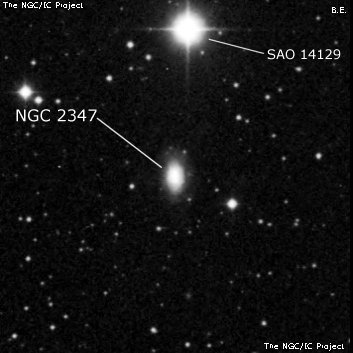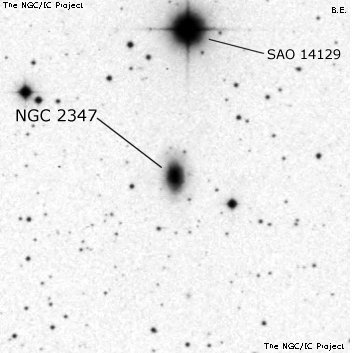NGC/IC Project Restoration Effort
(This is a very very beta version)
NGC2347


Basic Information
Location and Magnitude
Right Ascension: 7:16:4.0
Declination: +64:42:41
Constellation: CAM
Visual Magnitude: 12.5
Historic Information
Discoverer: Herschel W.
Year of discovery: 1788
Discovery aperture: 18.7
Observational
Summary description: vF, S, R, lbM
Sub-type: Sb
Corwin's Notes
=====
NGC 2347 and IC 2179. On 1 Nov 1788, William Herschel found a "vF, S, R, lbM"
nebula 01h 04m 05s following, 48' south of 36 Camelopardalis (the observation
is from Dreyer's 1912 collection of Herschel's papers). This position reduces
to 07 16 09, +64 46 (J2000) using the Hipparcos position of 36 Cam (with a
proper motion correction, too, though that changes the position by only about
7 arcsec between 1788 and 2000). The GC/NGC position precesses to 07 16 20,
+64 48. Since no other reference for the position is given, I suspect that it
comes from a preliminary reduction by CH using an older position for the star.
Her position in her fair copy of WH's sweeps precesses to 07 16 19, +64 47.
Finally, Arthur Auwers's reduction of WH's positions put the object at
07 16 09, +64 46 (my thanks to Steve Gottlieb for reminding me about Auwers's
list -- "It takes a village"). All of these positions fall about 3-6 arcmin
north-following a 13th magnitude spiral galaxy (at 07 16 04.1, +64 42 41)
which is usually taken as NGC 2347.
However, 9 arcmin south-preceding the NGC position is a smaller, but equally
bright -- therefore, higher surface brightness -- S0 galaxy. This was found
by Bigourdan while he was searching the area of N2347, and is in IC2 as IC
2179. The IC position is within 2 arcmin of the correct position (07 15 32.3,
+64 55 34). Could this be the object that WH saw?
Bigourdan apparently thought so, since he assigned the number "NGC 2347" to
his observations of this smaller galaxy. However, he lists SA0 14129 as his
comparison star. Using the 2000 position for this, we find a position for the
galaxy of 07 16 15.1, +64 46 53, quite close to the NGC position for N2347.
This certainly explains Bigourdan's choice of this object for N2347.
If we look at this position on the sky, however, we find nothing at all. But
applying Bigourdan's offsets to the position for BD +65 560 = GSC 4119-00435
(a star about a magnitude fainter, but still bright), we land exactly on IC
2179. But Bigourdan's observations, referred to SAO 14129, of what he calls
"IC 2179," point exactly to the spiral usually called N2347. Thus, it's
clear that not only has Bigourdan misidentified his comparison star for I2179,
he has also switched the two catalogue numbers.
So where did the correct IC position come from? Bigourdan published his "new"
nebulae in several short lists in Comptes Rendus; these were Dreyer's primary
souce for Bigourdan's positions. Indeed the position in Bigourdan's CR 123,
1243, 1896 is the IC position. Curiously, in his collected lists of "novae"
in the introduction to his observations, Bigourdan prints the incorrect
position given in the observations themselves, though does call it IC 2179. I
have not yet found why he discarded his previously published position.
In any event, the identifications are clear if we ignore Bigourdan's mistaken
identifications for his comparison stars. NGC 2347 is the south-following
spiral, and IC 2179 is the north-preceding lenticular. See also some
additional discussion under IC 2179.
Steve's Notes
=====
NGC 2347
13.1" (1/11/86): fairly faint, fairly small, bright core, slightly elongated N-S, diffuse. Located 4' S of mag 7.3 SAO 14129. A mag 10 star lies 5.2' NE. Forms a wide pair with IC 2179 = UGC 3750 13' N.



